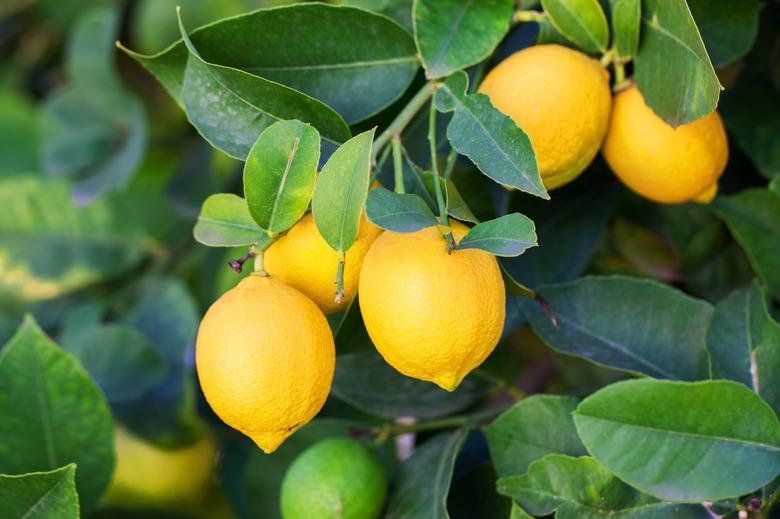How To Kill Black Mold On Citrus Trees
If you've noticed a black fungus on your lemon tree leaves (Citrus limon, USDA zones 8 to 11) or your other citrus trees (Citrus spp., USDA zones 8 to 11), your plants are covered in sooty mold. When taking a closer look at your plants. you'll probably notice tiny pests like aphids or whiteflies; these are the cause of the sooty mold. Although in most cases sooty mold won't damage or kill your citrus, it can be unsightly. You can wash the mold from the citrus foliage, but controlling the outbreak of pests will stop the sooty mold from forming to start with.
Characteristics of Sooty Mold
Sooty mold is most commonly caused by the fungi belonging to the genera Scorias, Capnodium, and Fumago. It earns its common name because it resembles a layer of black soot covering portions of the citrus plant. You will commonly find sooty mold covering citrus fruits, small branches, foliage, and twigs. An outbreak of sooty mold results in black spots on lemon tree leaves as well as the leaves of all types of citrus.
If you notice sooty mold covering portions of your citrus, you have a problem with pests like aphids and whiteflies. These pests have sucking mouthparts that feed on the plant's sap, after which the pests excrete a sticky, sweet substance called honeydew on which the sooty mold grows. When sooty mold appears, it's usually a sign that you have a large population of these sucking insects infesting your citrus tree.
Although sooty mold won't typically kill or damage your citrus plants, an outbreak covering large portions of the tree can interfere with photosynthesis. Photosynthesis is reduced, which leads to a delay in the coloring of the fruits, stunted growth, and leaf drop. You can control sooty mold by controlling the insects causing it, although a small amount of sooty mold won't harm the tree. Otherwise, you can remove it by spraying the area with water or washing off affected portions with soap and water.
Controlling Aphids Causing Sooty Mold
Aphids are small, pear-shaped insects that reproduce asexually so populations can quickly infest citrus. They feed on new flushes of foliage, resulting in stunted and distorted leaves, including cupped, twisted, or curling leaves. They cause the most damage to young citrus trees.
Aphids common to citrus are brown citrus aphids, black citrus aphids, green citrus aphids, and cotton aphids. The pests are colored black, brown, and green to pale yellow and congregate in large populations on the leaves and along the branches. A sure sign you have aphids is finding ants traveling along the branches to the aphids which they "milk" to extract the honeydew.
If the population of aphids infesting your citrus is small, natural predators like ladybugs or ladybird beetles will usually take care of the problem. However, if the aphid population has grown out of control, you can kill them by saturating the pests with insecticidal soap. Products like neem oil and horticultural oils also kill the pests, but be sure to follow label instructions for proper application.
Controlling Whiteflies Causing Sooty Mold
Whiteflies are another pest with sucking mouthparts that attack citrus plants and cause large amounts of sooty mold. Adult whiteflies have wings and lay their eggs on the underside of the foliage, turning into clear nymphs. Types of whiteflies that infest citrus are the citrus whitefly, which is white with a yellow abdomen; the cloudy-winged whitefly, which is white and slightly bigger than the citrus whitefly; bayberry whitefly, which is white and the smallest type; and the wooly whitefly, which has unmarked wings and leaves a white wooly-looking substance on the leaves.
There are a variety of natural predators that take care of whitefly populations on citrus, including lady beetles and parasitic wasps, as well as various fungi and lacewing larvae. Whitefly populations rarely need control with insecticides but if the pest population is increasing, use a product like horticultural oil to kill the pests along with their larvae. Always read and follow the label instructions on properly applying the product.
References
- Old Farmer's Almanac: Citrus: Lemons, Oranges, and Limes
- Old Farmer's Almanac: How to Identify and Get Rid of Aphids
- UC IPM: Sooty Mold
- UF IFAS Extension: A Guide to Identification of Soft-Bodied Citrus Insect Pests
- UF IFAS Extension: Lemon Growing in the Florida Home Landscape
- NC State Extension: Citrus Whitefly
